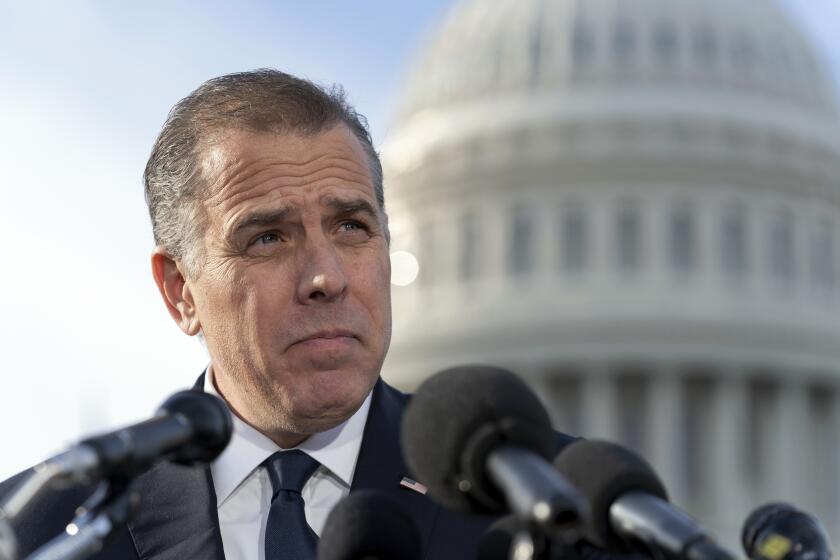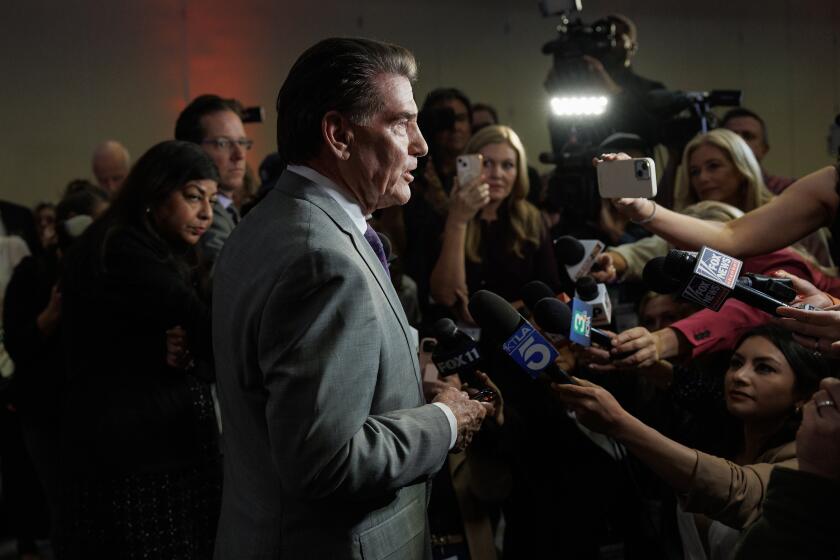Essential Politics: Trump is trapped in his bubble — and second place

What’s the biggest difference between the Donald Trump of 2016 and the one who appeared on the debate stage Thursday night? The bubble may be the answer.
Four years ago, then-candidate Trump had many of the same character traits that a majority of Americans have wearied of — the boastfulness, the quarrelsomeness, the self-absorption. But along with that, he also had a keen grasp of how to pitch to a mass audience, a skill honed by years of success in marketing his businesses and himself.
He used that skill relentlessly in his 2016 campaign to drive home a consistent message: America had a corrupt, self-serving political elite that had sold out the average working man, he said; Hillary Clinton embodied that elite, and he stood outside of it.
Get our L.A. Times Politics newsletter
The latest news, analysis and insights from our politics team.
You may occasionally receive promotional content from the Los Angeles Times.
That message allowed him, just barely, to edge past Clinton and into the White House.
Four years later, that easy communication with the public eludes Trump. In part, that’s because Joe Biden provides a much harder target than Clinton did. In part, however, Trump has simply lost his touch at communicating with people outside the bubble.
Suit of armor becomes a straitjacket
Since his campaign began, Trump has devoted enormous energy to attacking the news media, outside experts and any other potential critics in order to delegitimize them in the eyes of his followers. The strategy isn’t subtle or secret; he and his aides have strived to build a walled garden in which he, and he alone, would serve as arbiter of the truth.
That’s worked to a significant extent. As the Pew Research Center has found, about one in eight Americans rely solely on conservative media and Trump for their information about politics and public affairs. A different question Pew asked, focused on the coronavirus, found a somewhat larger group, about one in six, who said they relied primarily on Trump and the White House for their information about the pandemic.
Across a wide range of issues, members of that group, who make up Trump’s most ardent supporters, have strikingly different views from the rest of the country, different even from fellow Republicans:
- They’re far more likely to see mail-in balloting as a source of voter fraud.
- About 90% say the country has done about as well as it could in controlling the pandemic.
- Seven in 10 say the threat from the virus has been overblown.
- Roughly half say the QAnon conspiracy theory is either a very good (15%) or somewhat good (31%) thing for the country.
The success of that closed information ecosystem explains a big part of why Trump’s core supporters so steadfastly back him through every turn of his administration. Inside the bubble, Trump literally can do no wrong. His often-repeated description of himself as now “immune” from the coronavirus may strike the rest of the country as silly boasting; within the bubble, it’s a powerful metaphor for his status as übermensch.
But nothing in life — certainly nothing in politics — comes cost-free.
For Trump, the cost of creating the bubble is living in it.
The constraints of the bubble help explain Trump’s inability to forthrightly condemn conspiracy theories or white supremacist groups. And they powerfully affect his ability to communicate with outsiders. Watch him on stage in a debate or a rally, and one sees a man who has grown so used to speaking to his followers in a shared, coded language that he now has trouble doing anything else.
In advance of Thursday’s debate, Republican strategists outside the Trump campaign said they hoped the president would talk about the economy and the contrast between his plans and Biden’s. He did, but mostly only in the debate’s final minutes, when he declared that “I’m cutting taxes, and he wants to raise everybody’s taxes. And he wants to put new regulations on everything. He will kill it. If he gets in, you will have a depression, the likes of which you’ve never seen. Your 401(k)s will go to hell, and it’ll be a very, very sad day for this country.”
That may not be an argument that most voters buy — recent polls have shown Biden picking up ground on the question of which candidate could better handle the economy — but it’s at least an assertion most voters understand.
Compare that with Trump’s opening volley, about 25 minutes into the debate, in his attack on the business dealings of the former vice president’s son, Hunter Biden.
“Joe got three and a half million dollars from Russia. And it came through [Vladimir] Putin, because he was very friendly with the former mayor of Moscow, and it was the mayor of Moscow’s wife. He got three and a half million dollars. Your family got three and a half million dollars and you know someday, you’re going to have to explain — why did you get three and a half?” he said.
To people who consume a steady diet of Sean Hannity or Rush Limbaugh, that allegation likely struck a chord; they’re familiar with the accusation and comfortable with the sketchy evidence on which it’s based, including a mysterious laptop that Trump’s lawyer, Rudy Giuliani, says once belonged to Hunter Biden. The rest of the nation was likely just puzzled: The mayor of Moscow’s wife?
When Biden shot back, a few minutes later, that Trump’s accusations were part of a “Russian plan” to sow disinformation in the U.S., Trump seemed genuinely surprised at an assertion which, outside his bubble, is widely taken as fact.
“You mean, the laptop is now another Russia, Russia, Russia hoax? You’ve got to be,” Trump said before Biden cut him off. “Is this where you’re going?” Trump continued. “This is where he’s going. The laptop is Russia, Russia, Russia? You have to be kidding here. Here we go again with Russia.”
In 2016, many voters were predisposed to suspect the worst of Hillary Clinton. Voters may not have followed all the baroque twists of the saga of her emails, but the controversy reaffirmed their feeling that she — a powerful member of the political class — thought she could play by different rules than everyone else.
For more than a year, Trump has tried every way he could to re-create that play, this time with Biden cast as the villain. To date, he’s failed.
In the latest Gallup poll, Biden has a positive public image (54% favorable to 43% unfavorable), compared with Trump’s negative rating (47% favorable to 51% unfavorable). In Gallup’s history with that question, going back to 1956, Trump, Clinton and Barry Goldwater were the only three candidates to go into the final weeks of an election with negative images.
If Trump loses his reelection bid — a prospect that grows more likely with each passing day — the best epitaph for his campaign could be a warning that the great theoretical physicist, Richard Feynman, delivered in a Caltech commencement address nearly half a century ago:
“The first principle is that you must not fool yourself — and you are the easiest person to fool.”
Immigration and the abuse of detainees
Immigration, an issue that dominated the 2016 campaign and much of Trump’s presidency, has been oddly absent from the current campaign. Trump seldom talks about the issue anymore, beyond somewhat perfunctory mentions of his border wall.
Thursday night’s debate illustrated one reason why: Any discussion of the topic moves rapidly to the separation of children from their parents at the border, which polling consistently has shown to be one of the most damaging moments of Trump’s presidency.
Biden repeatedly drove home that the administration has failed to locate the parents of more than 500 children who were taken from their families.
“Parents were ripped — their kids were ripped from their arms and separated. And now they cannot find over 500 sets of those parents, and those kids are alone. Nowhere to go, nowhere to go. It’s criminal. It’s criminal,” Biden said. He also pledged that he would submit an immigration bill to Congress within the first 100 days of his administration that would provide a path to citizenship for most of the roughly 10.5 million immigrants currently in the U.S. without legal authorization.
Trump displayed little concern about the fate of the children, blaming “coyotes and lots of bad people” for bringing them to the border and, repeatedly, stressing another of his pet grievances — that he had been blamed for wire mesh enclosures built during the Obama administration to hold migrant families.
“Who built the cages?” he demanded.
Family separation is only one of many abuses that have plagued the U.S. immigration detention system during the Trump years. Another is the abuse of detainees. We’ve published two powerful stories on that topic this week:
Paloma Esquivel and Andrea Castillo reported on the ways in which privately run immigrant detention centers and law enforcement agencies have failed to protect detainees from sexual abuse.
And Molly O’Toole reported on the growing number of women alleging that they were subjected to sterilization and other abusive medical procedures while detained at an immigration facility in Georgia.
At least 19 women now allege “overly aggressive” or “medically unnecessary” surgery without their consent, according to a new report written by a group of board-certified OB-GYNs and nursing experts who reviewed more than 3,200 pages of records, O’Toole reported. Other records she obtained, and interviews with some of the women, detail their experiences, which have come under investigation by the Homeland Security Department’s inspector general as well as members of Congress.
Enjoying this newsletter? Consider subscribing to the Los Angeles Times
Your support helps us deliver the news that matters most. Become a subscriber.
The latest from the campaign trail
— Biden’s campaign had three times more money than Trump’s as they moved into the final weeks of the campaign, Seema Mehta reported. The gap has two big causes: the extraordinary outpouring of donations for Biden, which has boosted his fundraising far above expectations, and the equally extraordinary level of spending by the Trump campaign, which blew through $1 billion by summer, with significant amounts going to waste.
— After being her own boss, Kamala Harris is embracing her new role as Biden’s No. 2, Melanie Mason reported.
— “Tweeting at the television doesn’t fix things,” former President Obama declared as he made his first campaign appearance for Biden — a rally in Philadelphia. Rather than play the role of retired statesman floating above it all, Obama seemed to revel in his red-meat attacks against Trump, Matt Pearce reported.
— Iran and Russia have tried to interfere in this year’s election, the FBI and intelligence officials confirmed this week. As Chris Megerian reported, John Ratcliffe, the national intelligence director, insisted that Iran’s interference was aimed at trying to undermine Trump, but the evidence called that assertion into question.
— Even if Trump loses, Trumpism may outlast him, Noah Bierman writes. Within the Republican Party, some figures are trying to plan out a non-Trump future, but so far they appear to be a minority. Instead, Republicans who hope to run for president in 2024 are competing to display their pro-Trump credentials.
Recapping the debate
Miss the debate? Need a refresher?
— Trump was calmer, but not necessarily more effective, Janet Hook wrote in her assessment of the evening.
— Evan Halper, Britny Mejia and Bierman wrote this full recap of the evening.
— Mark Barabak provided these key takeaways from the encounter.
— Megerian headed up our effort to fact-check the candidates’ statements. Trump uttered a lot of falsehoods; Biden had a few, too.
— Here’s our round-by-round scorecard of the major moments and how the candidates did.
— How did the media assess the debate? Hannity said Trump won, but he was the outlier, Jim Rainey, Arit John and Tyrone Beason reported.
The latest from Washington
As wildfires explode in the West, the U.S. Forest Service can’t afford prevention efforts, Anna Phillips reported. The Forest Service has a backlog of millions of acres of forest management projects, but lacks the money to take them on, Phillips found.
The House of Representatives’ class of 2018 took office with high hopes. Did it deliver? Jennifer Haberkorn and Sarah Wire took a look. The freshman class was young, outspoken and diverse, and they certainly changed the tone of the House. But they don’t have any major legislative accomplishments to boast of, largely because of the deadlock between the Democratic House and the Republican Senate.
“Our mark is more institutional than it is legislative,” Rep. Katie Porter (D-Irvine), said. In time, she said, “changing the institution to make it work better will ultimately produce better legislation.”
The Senate Judiciary Committee advanced Amy Coney Barrett‘s nomination to the Supreme Court over a Democratic boycott, Haberkorn reported. The full Senate is set to confirm Barrett on Monday.
The U.S. is offering to mediate the dispute between Armenia and Azerbaijan that has led to warfare in recent weeks, Tracy Wilkinson reported. Russian-led negotiations have gone nowhere so far. Secretary of State Michael R. Pompeo will now try his hand, meeting with the foreign ministers of the two nations.
Stay in touch
Send your comments, suggestions and news tips to politics@latimes.com. If you like this newsletter, tell your friends to sign up.
Until next time, keep track of all the developments in national politics and the Trump administration on our Politics page and on Twitter at @latimespolitics.
Get the L.A. Times Politics newsletter
Deeply reported insights into legislation, politics and policy from Sacramento, Washington and beyond. In your inbox three times per week.
You may occasionally receive promotional content from the Los Angeles Times.




